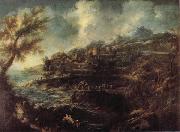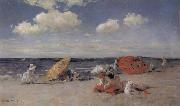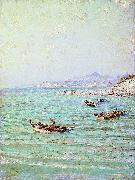Wholesale Oil Painting Reproductions No Minimum and Door to Door! |
|||||||||||
|
|
|||||||||||

|
|||||||||||
|
|
|
||||||||
All MAGNASCO, Alessandro Oil Paintings |
||||||||
|
|
||||||||
|
|
||||||||
|
Artist Introduction: Italian Rococo Era Painter, 1667-1749
Painter and draughtsman, son of (1) Stefano Magnasco. He did not study with his father, who died when he was a small child. He went to Milan, probably between 1681 and 1682, and entered the workshop of Filippo Abbiati (1640-1715). His Christ Carrying the Cross (Vitali, priv. col., see Franchini Guelfi, 1987, fig. 238) faithfully repeats the subject and composition of Abbiati's painting of the same subject (Pavia, Pin. Malaspina). Alessandro Magnasco's early works were influenced by the harsh and dramatic art of 17th-century Lombardy, with dramatic contrasts of light and dark and livid, earthy tones, far removed from the bright, glowing colours of contemporary Genoese painting. The depiction of extreme emotion in the St Francis in Ecstasy (Genoa, Gal. Pal. Bianco) was inspired by Francesco Cairo's Dream of Elijah (Milan, S Antonio Abate). However, Magnasco was already expressing himself in a very personal manner, with forms fragmented by swift brushstrokes and darting flashes of light. The Quaker Meeting (1695; ex-Vigan? priv. col., see Franchini Guelfi, 1991, no. 18) is one of his first genre scenes. In this early period he specialized as a figurista, creating small human figures to be inserted in the landscapes and architectural settings of other painters. He also began collaborating with the landscape painter Antonio Francesco Peruzzini, with a specialist in perspective effects, |
||||||||
|
|
||||||||
|
Seashore Painting ID:: 28406 |
mk60
1720
Oil on canvas
62x83"
|
|||||||
Height Width |
INS/CM Quality |
|||||||
|
X |
| |||||||
|
|
||||||||
All William Merritt Chase Oil Paintings |
||||||||
|
|
||||||||
|
|
||||||||
|
Artist Introduction: American Impressionist Painter, 1849-1916
American painter and printmaker. He received his early training in Indianapolis from the portrait painter Barton S. Hays (1826-75). In 1869 he went to New York to study at the National Academy of Design where he exhibited in 1871. That year he joined his family in St Louis, where John Mulvaney (1844-1906) encouraged him to study in Munich. With the support of several local patrons, enabling him to live abroad for the next six years, Chase entered the Kenigliche Akademie in Munich in 1872. Among his teachers were Alexander von Wagner (1838-1919), Karl Theodor von Piloty and Wilhelm von Diez (1839-1907). Chase also admired the work of Wilhelm Leibl. The school emphasized bravura brushwork, a technique that became integral to Chase's style, favoured a dark palette and encouraged the study of Old Master painters, particularly Diego Velezquez and Frans Hals. Among Chase's friends in Munich were the American artists Walter Shirlaw, J. Frank Currier and Frederick Dielman (1847-1935) |
||||||||
|
|
||||||||
|
|
Seashore Painting ID:: 37369 |
mk124
50.8x86.4cm
About 1892
|
||||||
Height Width |
INS/CM Quality |
|||||||
|
X |
| |||||||
|
|
||||||||
All unknow artist Oil Paintings |
||||||||
|
|
||||||||
|
|
||||||||
|
Artist Introduction: |
||||||||
|
|
||||||||
|
|
Seashore Painting ID:: 72102 |
"Seashore". Oil on cardboard. 37.2 x 66.5 cm
cjr |
||||||
Height Width |
INS/CM Quality |
|||||||
|
X |
| |||||||
|
|
||||||||
All Eduard Gaertner Oil Paintings |
||||||||
|
|
||||||||
|
|
||||||||
|
Artist Introduction: 1801-1877
German
Eduard Gaertner Gallery
German painter and lithographer. His father was a master carpenter and his mother a gold embroiderer, and he had his first drawing lessons in 1811 in Kassel, where he had gone with his mother after the occupation of Berlin. After returning to Berlin he became in 1814 an apprentice painter at the Kenigliche Porzellanmanufaktur; and from 1821 he studied under Carl Wilhelm Gropius (1793-1870), then engaged as a painter of stage sets at the Kenigliches Theater in Berlin and also known for his townscapes. Here Gaertner developed skill in the rendering of perspective. He first exhibited at the Akademie der Kenste, Berlin, in the following year. In 1824-5 he was commissioned to paint interior views of Berlin Cathedral (see fig.) and the chapel of the Schloss Charlottenburg (both Berlin, Schloss Charlottenburg). In return, he was granted funds to enable him to spend three years in Paris, where he studied under Francois Bertin. Gaertner views of Paris already show his gift for lighting and use of staffage. His special ability lay in his understanding of the character of a city as the work of its inhabitants. After his return to Berlin he swiftly established himself as the leading painter of urban views, which he regularly showed at Berlin Akademie exhibitions. Interest in this genre grew along with the spate of building activity in Berlin after the end of the wars against Napoleon. There was a fresh interest in paintings of new buildings in particular, intended for a local rather than a visitors market. Two large views of the former Berlin Schloss, The Schleterhof and The Eosanderhof (both 1831; Potsdam, Neues Pal.), show Gaertner bold use of light and shadow. With the six-part panorama View over Berlin from the Roof of the Friedrich-Wedersche Church (1834; Berlin, Schloss Charlottenburg) Gaertner showed the spread of the city by this time. After painting a replica of this work for the Prussian king daughter Alexandra Feodorovna, Empress of Russia, in 1835-6 (St Petersburg, Hermitage), Gaertner visited Russia in 1837, and again from 1838 to 1839, staying in both St Petersburg and Moscow. He completed a large number of city views, including a three-part view of The Kremlin (1839; Berlin, Schloss Charlottenburg), commissioned by Frederick William III. With the death of the Prussian king in 1840, Gaertner lost his most powerful patron and interest in his work began to wane as it came to seem too stiff and objective to Romantic sensibilities. Gaertner tried to adapt to the change in taste, adopting a more painterly approach; in particular, he paid attention to effects of lighting. The vogue for city views had passed its peak, however, and Gaertner turned to landscape painting. Journeys to Prague in 1841-2, through West and East Prussia in 1845-6, and to Silesia in 1848-51 introduced new subjects; but it was architecture rather than setting that most engaged Gaertner attention. At this period he occasionally also invented ideal landscape settings for real buildings, as in the Ruined Monastery of Lehnin in an Imaginary Mountain Landscape (Berlin, Schloss Charlottenburg). Gaertner also produced watercolours of interiors and lithographs of both landscape and city views; but after the middle of the century his productivity in all respects dwindled. (An example of his work from this period is his oil painting of the Bauakademie and Friedrich-Wedersche-Kirche in Berlin (1868; Berlin, Tiergarten, N.G.; see SCHINKEL, KARL FRIEDRICH, fig. 2).) The rise of photography appeared to be making the architectural painter redundant. |
||||||||
|
|
||||||||
|
|
Seashore Painting ID:: 73654 |
Oil on cardboard. 37.2 x 66.5 cm
cyf |
||||||
Height Width |
INS/CM Quality |
|||||||
|
X |
| |||||||
|
|
||||||||
All Nikolay Nikanorovich Dubovskoy Oil Paintings |
||||||||
|
|
||||||||
|
|
||||||||
|
Artist Introduction: Russian, December 17, 1859 - February 28, 1918) was a Russian landscape painter.
He studied from 1877 to 1881 at the Imperial Academy of Arts in Saint Petersburg under Mikhail Konstantinovich Klodt. In 1886, he became a member of the Peredvizhniki (the Wanderers), a group of Russian painters. In 1900, he became a member of the Academy of Arts. |
||||||||
|
|
||||||||
|
|
Seashore Painting ID:: 86637 |
1917. Oil on canvas
cjr |
||||||
Height Width |
INS/CM Quality |
|||||||
|
X |
| |||||||
|
|
||||||||
All Gustave Courbet Oil Paintings |
||||||||
|
|
||||||||
|
|
||||||||
|
Artist Introduction: 1819-1877
French
Gustave Courbet Locations
was a French painter whose powerful pictures of peasants and scenes of everyday life established him as the leading figure of the realist movement of the mid-19th century.
Gustave Courbet was born at Ornans on June 10, 1819. He appears to have inherited his vigorous temperament from his father, a landowner and prominent personality in the Franche-Comte region. At the age of 18 Gustave went to the College Royal at Besancon. There he openly expressed his dissatisfaction with the traditional classical subjects he was obliged to study, going so far as to lead a revolt among the students. In 1838 he was enrolled as an externe and could simultaneously attend the classes of Charles Flajoulot, director of the ecole des Beaux-Arts. At the college in Besançon, Courbet became fast friends with Max Buchon, whose Essais Poetiques (1839) he illustrated with four lithographs.
In 1840 Courbet went to Paris to study law, but he decided to become a painter and spent much time copying in the Louvre. In 1844 his Self-Portrait with Black Dog was exhibited at the Salon. The following year he submitted five pictures; only one, Le Guitarrero, was accepted. After a complete rejection in 1847, the Liberal Jury of 1848 accepted all 10 of his entries, and the critic Champfleury, who was to become Courbet first staunch apologist, highly praised the Walpurgis Night. |
||||||||
|
|
||||||||
|
|
Seashore Painting ID:: 98239 |
1867(1867)
Medium oil on canvas
Dimensions 55 x 65 cm
cyf |
||||||
Height Width |
INS/CM Quality |
|||||||
|
X |
| |||||||
|
|
||||||||
|
Prev Next
|
||||||||
|
|
||||||||
|
Related Paintings to Gustave Courbet :. |
||||||||
|
|
||||||||
|
CONTACT US |






